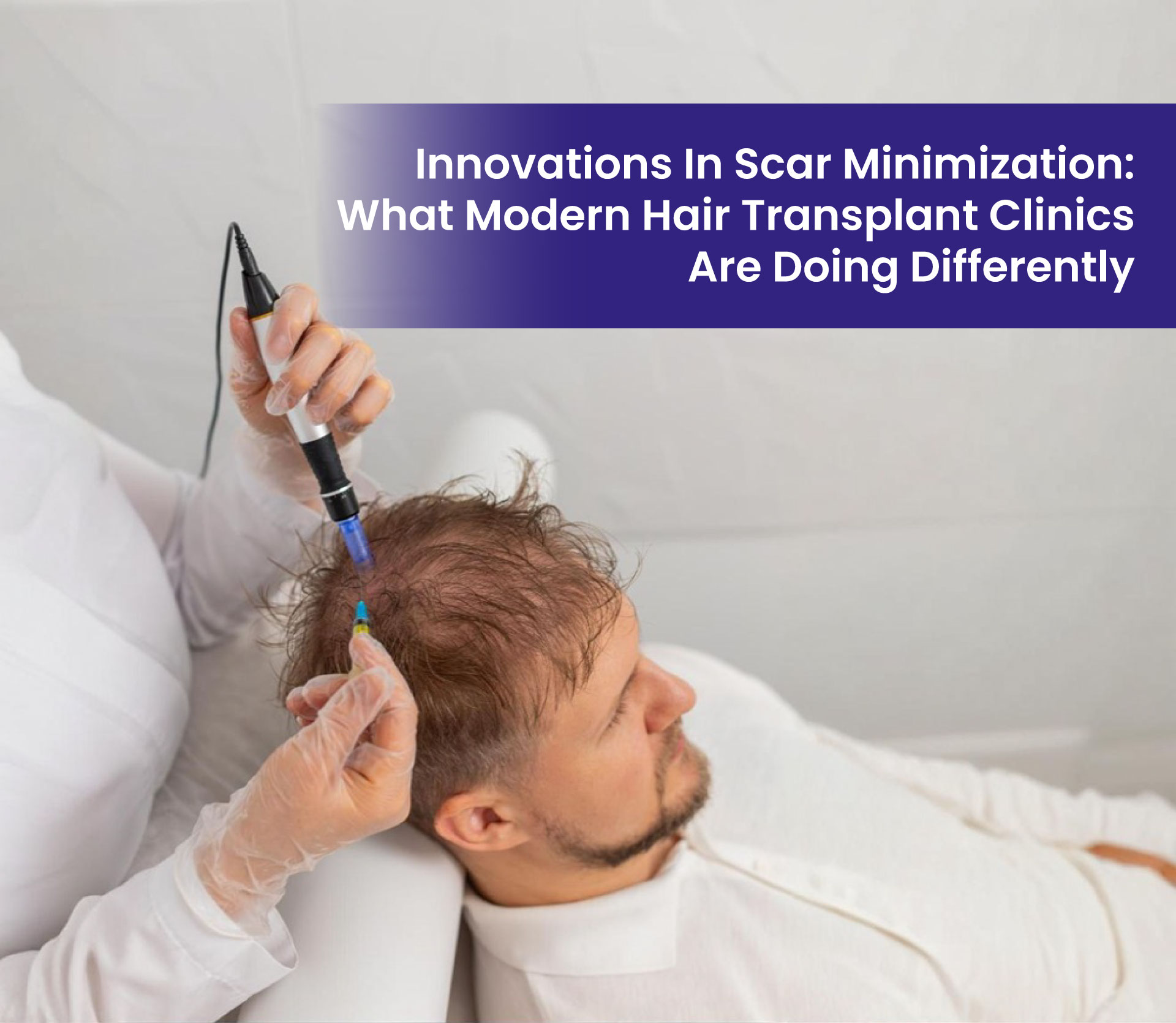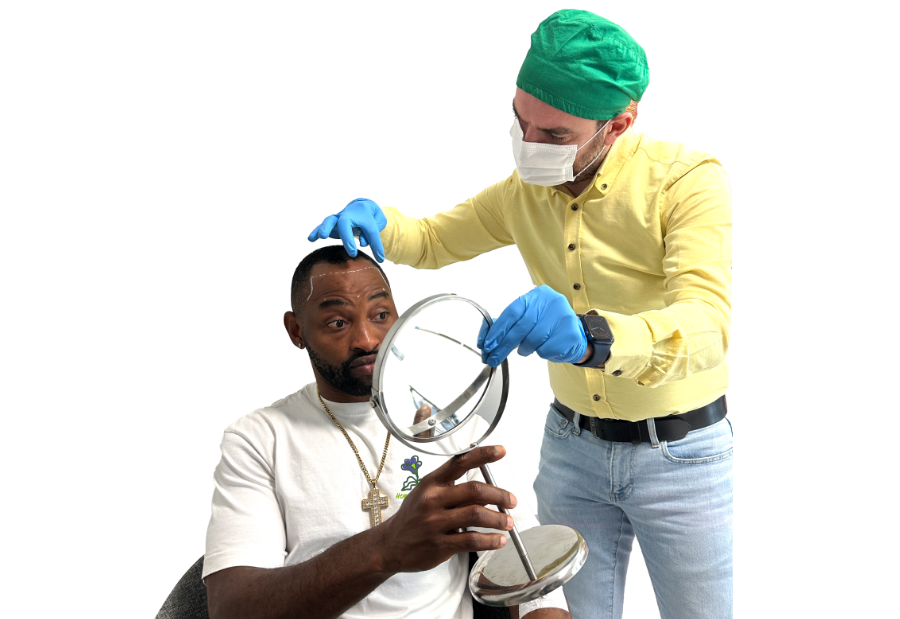Get 25% OFF Hair Transplant Packages This New Year — Book Today!
Innovations in Scar Minimisation: What Modern Hair Transplant Clinics Are Doing Differently

Introduction: From Visible Scars to Virtually Undetectable Results
Hair transplants have come a long way. A decade ago, many patients worried less about growth and more about the scars left behind. Long, obvious lines or scattered dots on the scalp often told the story of surgery. Today, that’s no longer the case. Modern hair transplant clinics have adopted new tools and refined methods to cut scarring down to a nearly invisible level. This change is altering what results look like as well as how quickly people recuperate.
This article will look at the hair transplant clinics and how they perform to minimize scarring, the surgeon’s skill and aftercare, and the patient’s options if scarring occurs.
Understanding Scarring in Traditional Hair Transplant Techniques
1. What Causes Scars in Hair Transplants?
Scars form when the skin heals after an incision. In hair transplant clinics, they come from the removal of grafts or from the way the donor area is closed. Factors like skin type, healing ability, and aftercare also influence how visible a scar becomes.
2. Difference Between Linear vs. Dot Scarring
FUT: This old technique takes a strip of skin from the donor area, leaving a thin line across the back of the scalp.
FUE: This technique extracts individual hairs and leaves micro-circular marks, so while you may not be able to see the marks as much, if it is done improperly, it may backfire and still be visible when aggregated together in the fresh strip of hair taken from the donor area.
Both techniques can work well; however, the actual scarring will be individual to the method and the skill of the surgeon.
Key Innovations in Scar Minimization Techniques
1. Ultra-Refined FUE with Micro Punches
Traditional FUE had larger punches, which left larger visible marks. Now, hair restoration specialists often work with punches as small as 0.6 to 0.8 millimeters. These instruments take grafts with vestiges of trauma to the skin; consequently, they advance healing time and enable smaller scars with the ability to assimilate into other adjacent hair.
2. Trichophytic Closure in FUT
Some patients still choose FUT for high graft numbers. Modern hair transplant clinics reduce scarring in these cases with trichophytic closure. This method angles the edges of the wound so hair can grow through the scar. Over time, this growth helps hide the line completely.
3. Robotic-Assisted Hair Transplantation (ARTAS, NeoGraft)
Robotics has improved accuracy. Systems like ARTAS will help in graft extraction and maintain the appropriate distance and depth and avert problems with odd-shaped marks left by manual techniques. Robotics will not eliminate scaring, but it will implicitly lessen patient risks caused by human error, which in turn has reduced patient concerns and minimizes scarring.
4. DHI (Direct Hair Implantation)
With Direct Hair Implantation, grafts are placed directly into the scalp using special implantation pens. Since there’s no need to create recipient slits in advance, scarring in the implanted area is minimal. This approach also increases graft survival rates.
5. Sapphire FUE Hair Transplantation
Sapphire FUE Hair Transplantation is an advanced technique that uses sapphire blades instead of traditional steel tools, ensuring finer incisions and minimal tissue damage. This method promotes faster healing, higher graft survival, and more natural-looking hair density. It is especially effective for patients seeking precision, reduced scarring, and long-term results. At Grace Touch Clinic, our specialists combine expertise with cutting-edge technology to deliver safe and effective Sapphire FUE procedures.
Scar Minimization Strategies Beyond Technology
1. Surgeon Skill & Precision
While we can use incredible tools, the results are still largely reliant on the surgeon. A doctor for hair transplant procedures has to be vigilant with punch depth, angle and spacing. A small mistake while harvesting hair can generate an uneven scar, while meticulously outlining graft boundaries can make scars almost disappear.
2. Strategic Donor Area Management
Veteran surgeons do not take too many grafts from anywhere; they space out their extraction over a much larger donor area. This avoids over-extraction, and reduces the incidence of bald patches and clustering of scars.
3. Scalp Micropigmentation (SMP) for Scar Camouflage
When the scars remain prominent, SMP is an excellent option. SMP consists of creating tiny pigment dots in the skin to imitate hair follicles. This is successful because the figure combines with natural hair growth patterns. It is especially effective for patients with shorter hairstyles.
4. Post-Op Aftercare for Scar Reduction
Healing care is as important as the surgical technique. In established modern hair transplant clinics, the patient is continually informed with details for treatment during healing. For example,
- Using silicone gels to soften healing areas of the skin.
- Using PRP (Platelet-Rich Plasma) injections to speed healing and recovery time.
- Avoid direct sunlight to prevent scar darkening.
For detailed post-transplant hair care tips, check out our complete guide that ensures healthy growth and long-lasting results.
Case Studies: Before and After Scar-Free Results
Many patients today walk away with results that are hard to distinguish from natural growth. A restore hair clinic might showcase side-by-side images of patients who’ve had micro-FUE or robotic extraction. In these, donor areas appear smooth and healed, with little to no trace of surgery.
Seeing 2000 hair graft before and after images is often what reassures patients most. Clean donor areas and natural growth at the front line demonstrate how far we’ve come with these innovations.
Check out our hair transplant before and after results to see real transformations and understand what you can expect from the procedure.
FAQs: Scar Minimization in Hair Transplants
Q1. Are hair transplants truly scarless?
Not entirely. Any cut in the skin leaves some kind of mark. However, with modern methods, scars are often so fine that even close inspection doesn’t reveal them.
Q2. Which technique has the least scarring?
FUE with micro punches and DHI are probably the best things going right now. Patients often choose these when scar visibility is their main concern.
Q3. Can old transplant scars be treated?
Certainly, there are options like SMP and laser treatments, and revision surgery for some patients, as well as PRP for regenerating healthier skin above the top of preexisting scars.
Q4. Do robotic systems eliminate scarring completely?
No, but they provide a standard for the process. By keeping the depth consistent, along with spacing, it makes the scars smaller and more consistent so they’re less noticeable.
Conclusion: The Future of Hair Transplants Is Minimally Invasive
There is a distinct change in perspective of modern hair transplant clinics. Growth and coverage are still the goals, but patients also want clean donor areas without obvious scarring. Thanks to refined tools like sapphire blades, DHI pens, and robotic systems, these expectations are finally being met.
What used to be the main drawback of a transplant, the scar, no longer has to be a lasting reminder. With the right hair replacement doctor and careful aftercare, patients can heal faster, enjoy natural growth, and keep their donor areas looking untouched.
The future of hair restoration isn’t just about regaining hair. It’s about doing so in a way that feels seamless and natural, without the worry of scars giving anything away. And for many people searching for the best place to get hair transplant, that change makes the decision a lot easier.

